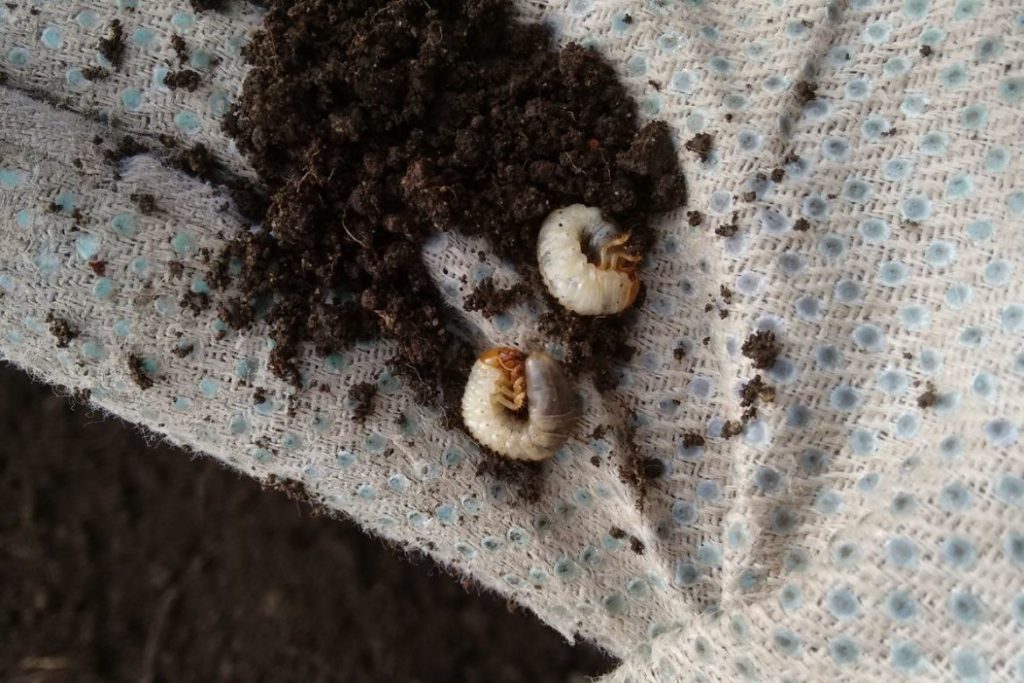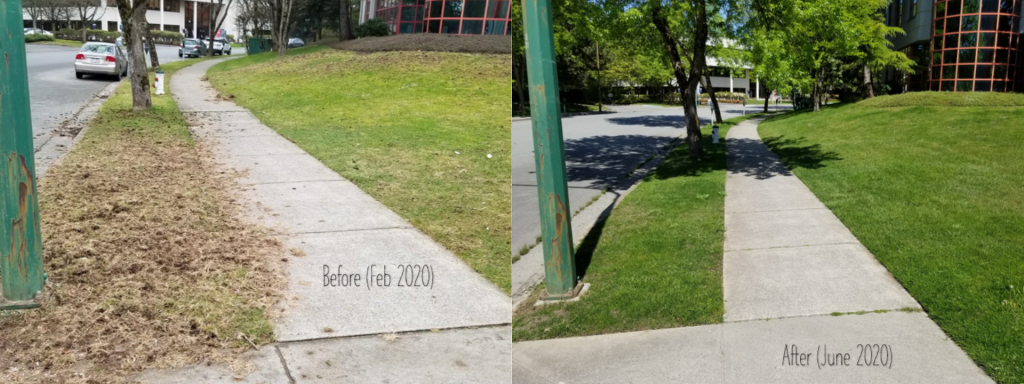If you’re in BC’s Lower Mainland and you’ve seen your lawns being pecked at and ripped apart by crows & rodents – and even if you haven’t – but you’ve seen neighboring lawns being destroyed – Then you will want to act very quickly!
The good news? Chafer Beetle marks are very treatable! However, the bad news is that the longer you wait the more likely you will see widespread damage on all your lawns as the Chafer Beetles move to new lawns around your property.
Our specialists have compiled everything you need to know to test for, identify, understand and deal with Chafer Beetle lawn damage…
Chafer Beetle Lawn Damage: What is a Chafer Beetle?

(Image: ISC)
Here’s what the Invasive Species Council of BC tells us about the European Chafer Beetle (Amphimallon majale):
• Came to BC in 2001, probably through infested turf
• Feeds on the roofs of turf grass
• Can cause crows, skunks, and raccoons to dig in a lawn for larvae
The ISC also provides these useful descriptions:
• Adult beetles: “…1-1.5 cm long with light brown wing coverings. The underside of their thorax is covered in white fluffy hair.”
• Larvae: “… between 0.5-2.5 cm long, they are C-shaped grubs that live underground. Their body is mostly white, the last two segments of their body are grey. They have a tan head capsule and three sets of short legs just behind the head.”
Damage to grass areas (much to the annoyance of property managers and owners) as a result of the presence of Chafer Beetle is very much a known Springtime issue in BC. But why is it the issue so prevalent during the Spring months? Keep reading to find out below.
Chafer Beetle Lawn Damage: 2, Why Springtime?
It’s simple:
• Chafer Beetles are laid in dryer lawns in summer
• Over the Winter they burrow deeper into the lawn to get away from the colder weather
• Larvae come closer to the surface in early Spring to hatch
• Once hatched they eat grass roots, weakening the lawn
• Animals seeking out the larvae will tear up your lawn during Spring
The damage should be easy to see as, depending on the time of year, you will notice crows & rodents pecking and tearing up the lawns resulting in loose soil & dead grass. As the warmer weather arrives the lawns become dried out and very patchy, those patches often fill in with moss & weeds.
Again, the worst thing to do is to ignore this damage in the hope that it will ‘just go away’ as curing the issue, and preventing further damage too, will reverse the long-term effects on your grass area.
Chafer Beetle Lawn Damage: 3, How Do I Treat Chafer Beetle Damage?
While many landscapers offer nematodes as a solution to this problem, our specialists have found over the years that nematodes are a very unsuccessful solution as they need to be put down in the early summer time. For the Nematodes to live and effectively kill off the Chafer Beetles the lawns need to be very heavily watered however this conflicts with very warm weather and watering restrictions.
Depending on where your property is located, our licensed, experienced applicators can apply a very safe and BC Government approved treatment called Acelepryn.
One of the reasons this application is so successful is because it gets applied in Mid-April to Mid-May (before the hot dry weather)
BC Government’s own resources offer reassurances about Acelepryn: “Acelepryn is registered by Health Canada for application to turf as a larvicide. The active ingredient is chlorantraniliprole, which is also registered in Canada for use on many food crops for insect control under other trade names including Altacor and Coragen.
“The larvicide only targets root eating grubs, and will not impact people, pets, mammals, birds, bees, butterflies or other animals.”
It cannot be overemphasised that the correct time to apply this one-time treatment is late April or early May, as this will prevent damage from larvae in late May and June. This means that NOW is the time to get quotes on this application.
Chafer Beetle Lawn Damage: 4, How About General Prevention?
Like many landscaping tasks, good general lawn care, carrying out checks ahead of time plus some forward planning can help ‘design out’ Chafer Beetle damage in multiple ways:
• Keeping a well-watered and healthy lawn to avoid the dry soil Chafer Beetles prefer
Let your lawns grow a bit longer as it makes it harder for the Chafer Beetles to enter the lawns, but it also makes it more difficult for the crows to access the beetles.
• Mixing grass seeds, such as clover (see below), as the grubs will not feed on these
• Test all grass for an infestation by cutting down a square foot, two inches down, then checking for more than five grubs.
Resources produced by the City of North Vancouver recommend the following checklist is taken into account when closing a different type of grass seed:
• “Do your research: How will your lawn area be used? Will you only occasionally walk on it or not at all? Will you need to rake leaves from surrounding trees?”
• “What is your sun exposure? Full sun or more shady? How hot (or not) does it get in the summer?”
• “What is your soil like? Does it drain well or hold a lot of water?”
• “What kind of plants do you want to look at? Uniform height and colour or a real mix of plants? Would you like flowers? Evergreen or deciduous?”
The resources suggest clovers, sedges, herbs, ornamental grasses and sedums are possible alternatives for planting.
However, as you’ll be working with a professional and established commercial landscape company like Premier Landscaping, the guesswork is removed from the process as all the important factors will be considered for you and recommendations based on proven know-how will be drawn up.
Why You Should Make Premier Landscaping Your Next Call

Our exacting standards and large community of experienced landscaping perfectionists mean we’ve been the trusted choice for clients throughout Greater Vancouver and Fraser Valley for over 40 years!
We can manage substantial portfolios and, through a single Client Care Manager, our famous dedication to superb client experience and quality of work applies to everything we do.
We’re trusted to care for millions of square feet, all year round, at locations including educational facilities, commercial sites, strata residential areas, healthcare facilities and retail.
A low turnover of clients, and an even lower turnover of colleagues, across more than four decades adds up to personal service, absolute reliability and superb personal service every time.
We’re proud to do things differently! To discuss the best landscaping option for your commercial, Strata, healthcare, education or retail properties simply speak to a Premier Landscaping specialist. We’re here to help.
See also: Spring Landscaping Essentials, Allan Block vs Timber Retaining Walls




